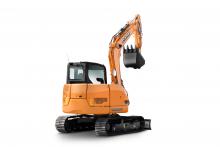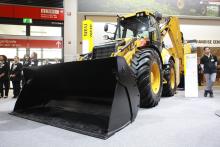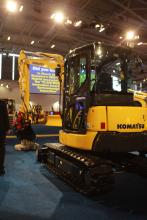Utility machines with standout efficiency and cutting-edge cab design have come onto the market during the first few months of 2013. Guy Woodford looks at some of them. Case Construction Equipment and New Holland Construction have brought out what they claim are the market’s first Tier 4 Final emissions standard midi-excavators. The CX75C SR and CX80C models from Case are said to offer more performance power and greater operator cabin comfort than previous models. Tier 4 Final standards are said to have bee
Utility machines with standout efficiency and cutting-edge cab design have come onto the market during the first few months of 2013. Guy Woodford looks at some of them
The CX75C SR and CX80C models from Case are said to offer more performance power and greater operator cabin comfort than previous models.
Tier 4 Final standards are said to have been met through the use of Cooled Exhaust Gas Recirculation (CEGR) combined with a Diesel Oxidation Catalyst (DOC) system. Case says there is no requirement for the two new mid-excavators to have a costly Diesel Particulate Filter (DPF), so there is no need for active filter regeneration that consumes fuel.
The CX75 SR and CX80C models’ completely redesigned cabs meet ROPS and FOPS Level II safety standards. Interior space has been increased, as the cab is 7% wider than the previous CX75 and CX80. A larger glazed area is also said to improve visibility to the front of the machine. Rear visibility has been improved with an optional rear view camera.
For applications that require additional safety, Case offers two different front screen guards and a certified lifting and handling kit to lift objects safely.
Case says the CX75C SR and CX80C generate 9% more hydraulic power than their predecessors, and 148litres/min of pump flow compared to the previous 136litres/min. Cycle times are said to be reduced and digging force improved by up by 3% with the new midi-excavators. In order to maximise uptime, the new machines feature a larger 120litre fuel tank, said to be easily fillable with the optional electric refuelling pump. Quick and easy maintenance is said by Case to be another advantage of the two new models.
With a choice of three boom systems, (mono-boom, swing-boom and offset-boom), four auxiliary hydraulic control systems (either hand or foot controlled), three track options (rubber or steel shoes) and two dipper-stick lengths, Case says its C Series mid-size excavators are effective in a wide variety of applications.
Meanwhile, New Holland’s Tier 4 Final emissions compliant E75C SR and E85C MSR midi-excavators are also said to raise the bar on the excellent performance and fuel economy that their predecessors were known for.
More power with the CEGR + DOC Tier 4 Final solution and high efficiency electro-hydraulic controls are said to be among the key features of the new models; as is claimed up to 31.4% fuel savings with the innovative Intelligent Total Control System and new ECO mode; claimed best-in-class controllability and swing speed with the new three-pump hydraulic system; and extremely quiet operation at just 69dBA inside the cab with the exclusive integrated Noise & Dust reduction( iNDr) system.
The new EVO cab on both its new model excavators is said by New Holland to offer more comfort and safety, with low operating costs and simplified maintenance among other claimed benefits of the 7.54tonne operating weight E75C SR and the 8.27tonne operating weight E85C MSR.
The full size glass window on the right of the EVO cab is said to provide unimpeded visibility. Both midi-excavator models also include as standard many features from the heavy line, such as the automatic air conditioning, easy-to-ready digital cluster, and two-speaker FM/AM radio.
A self-diagnostic function provides early warning of any malfunctions to the electrical system and alerts when maintenance is due.
In the backhoe loader market,
The upgraded machines are part of Caterpillar’s development of its equal sized tyre (EST) machine range in line with the rest of the F Series product family.
In the European Union (
For markets with less stringent emissions standards than the EU, the F Series backhoe loaders will use the Cat 3054C engine, which has emissions levels equivalent to EU Stage II. Engines that meet EU Stage IIIA emissions standards are available in non-EU markets that require highly regulated emissions levels, such as Turkey.
The Cat 434F now has a full Autoshift transmission, while the Cat 444F is equipped with a stiffer torque converter, said to provide more power in hard bank and faster acceleration when roading.
Auto-align steering, said to provide a quick and easy switch of steering modes that allows the operator to continue his work without manually realigning the steering, is also a feature of both models.
The new F Series backhoe machines feature a new loader arm design, said to increase lift capacity at greatest height by as much as 36%. Additionally, loader improvements with true parallelism when raising the bucket are said to result in better material retention. Caterpillar says operators can also load trucks more easily without losing any material, thus improving productivity.
A new sloping engine hood design combined with improved hose routings is said to enhance operator visibility to the work tool, both over the hood and either side of the loader arms. This is said by Caterpillar to help with work tool precision required applications such as grading or grabbing.
Mounted on the front fender of the Cat 434F and Cat 444F models, a new footstep allows for a comfortable and safe stance when performing daily checks of regular service points. The engine side panels on both machines require no tools to remove, allowing technicians to access the engine with ease. A hinged cooling pack is said to further improve access for cleaning and servicing and helps reduce onsite downtime.
A non-metallic 160litre fuel tank reduces condensation and eliminates corrosion, improving Cat 434F and 444F model reliability.
A wealth of performance improvements are said to ensure that
Komatsu offers an optional factory-fitted double auxiliary circuit, which can be controlled by a double slider on the machine’s PPC joysticks. This enables higher performance and improved oil flow. By switching into the attachment work mode, the double circuit offers a range of working options. One additional hydraulic circuit can be used to operate attachments such as tilt buckets or hydraulic breakers. The second hydraulic line, with a lower oil flow rate, suits use with a roto-tilting attachment or a clamshell bucket, and for demolition equipment.
As well as allowing easy maintenance, the machine also features the firm’s sophisticated KOMTRAX satellite monitoring system, which can deliver machine data over the internet. It also allows owners or fleet managers to view the machine’s location, performance and service requirements.
Further claimed performance gains, compared to previous generation machines, are a main pump flow increase of 8%, while system pressure has risen to 350-370 kg/cm2. Bucket forces have been increased by 16% and arm forces by 6-16%, while lifting capacities have been boosted by 3-12% over the front of the excavators. The machines are said to offer a 10% increase in traction force as well as a 9% reduction in fuel consumption in some operating cycles.
The SD580 single drum roller, the SE10-35 forward vibratory plate and the DE35-42 reversible plate are
Weighing in at 73kg, the SE10-35 has a plate width of 35cm. The larger DE35-42 reversible plate uses a
The very low overall height of
Weighing 5.18tonnes and 5.6tonnes respectively, the two loaders offer tipping loads of 3.45tonnes and 3.85tonnes. Powered by a 45kW (61hp) engine, the L506C comes with a 0.8m³ bucket, while the L508C uses a 49kW motor and a 1m³ bucket.
The use of plenty of glass in the cabin of both machines is said to ensure good all-round visibility. The models’ lifting cylinder is centrally mounted on the tapered boom for improved visibility to the working area. With pallet forks fitted both machines can lift in excess of 2tonnes.







